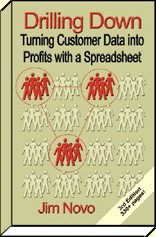
into Profits with a Spreadsheet
The Guide to Maximizing Customer Marketing ROI
Making Money with the Customer LifeCycle: Trip Wire MarketingFirst published 7/18/01 Jim's Intro: There is so much confusion surrounding how behavioral customer metrics are monitored and used I thought it was high time to write the story. Folks, none of this stuff is really hard and anyone can use these techniques with simple query tools - CRM not required. This article is Part One in a series of articles on Behavioral Marketing techniques. Part 2: Customer Latency
No question about it, the constant drumbeat of the CRM machine over
the past several years has confused the heck out of people. I've been
doing this stuff for almost 20 years now, and I can tell you it is not
as difficult as it is often portrayed. Sure, you can make it
very, very complicated if you want to. But if you don't start
with the basics, you're going to end up wasting a ton of money.
Let's start simple, shall we? Generally, CRM or Relationship Marketing attempts to define customer behavior and then looks for variances in behavior. When you hear people talk about "predictive modeling" or looking for "patterns" using data mining, they are essentially taking a behavioral approach using the latest tools. Once you know how "normal" customers behave, you can do two things with your business: * Formally document normal customer behavior and internalize it systemically, leveraging what you know to improve business functionality and profitability. * Set up early warning systems, triggering events, or "trip wires" to alert you to customer behavior outside the norm. This variance in behavior generally signals an opportunity to take action with the customer and increase their value - online or offline. What is most important to measure in CRM is change. People spend way too much time worrying about "absolute" numbers, like LifeTime Value. What they should really be looking at is "relative" numbers - change over time. It's not nearly as important to know the absolute value of a customer as it is to know whether this value is rising or falling - called the customer LifeCycle. Knowing and understanding the customer LifeCycle is the most powerful marketing tool you can have. Customers in the aggregate tend to follow similar behavioral patterns, and when any single customer deviates from the norm, this can be a sign of trouble (or opportunity) ahead. For example, if the average new cellular customer calls customer service 60 days after they start, and an individual customer calls customer service 5 days after they start, this customer is exhibiting behavior far outside the norm. Is there a potential problem, or opportunity? Is the customer having difficulty understanding how to use advanced services on the phone, or is the customer happily inquiring about adding on more services? In either case, there is an opportunity to increase the value of the customer, if you have the ability to recognize the opportunity and react to it in a timely way. Understand, there is no "average customer," and a business will have many different customer groups, each exhibiting their own kind of "normal" behavior. The tools available to identify and differentiate customer segments using behavioral metrics are discussed at length on almost every page of this web site. For example, the type of media or offer used to attract the customer can have a dramatic effect on long term behavior, and customers who come into the business on the same media and offer will tend to behave in similar ways over time. In the cell phone case above, the measurement of Latency (number of days until customer service call) serves as the "trip wire," a raising of the hand by the customer, to say to the marketer "I'm different. Pay attention to me." It is then up to the marketing behaviorist to determine the next course of action. Metrics like Latency provide the framework for setting up the capability to recognize the opportunity for increasing customer value. This raising of the hand by customers, and the reaction by marketers, is the feedback loop at the center of Relationship or LifeCycle based marketing. It's a repeating Action - Reaction - Feedback cycle. The customer raises the hand, the marketer Reacts. The customer provides Feedback through Action - perhaps they cancel service, or perhaps they add service. The marketer reacts to this Action, perhaps with a win-back campaign, or with a thank you note. It's a constant (and mostly non-verbal) conversation, an ongoing relationship with the customer which requires interaction to sustain. It is not a relationship in the "buddy-buddy" sense. Customers don't want to be friends with a company, they want the company to be responsive to their needs - even if they never come out and state them openly to the company. This relationship continues to cycle over and over as long as there is value in the relationship for both the customer and the marketer. If the customer takes an Action and there is no Reaction from the marketer, value begins to disappear for the customer, and they may defect. When value disappears for the marketer (the customer stops taking Action / providing Feedback), marketers should stop spending incremental money on the customer. Notice I did not say "fire the customer" or any of the related drivel thrown around in some of the CRM venues. All customers deserve (and pay for) a certain level of support. The real question is this: for each incremental, or additional dollar spent on marketing to the customer, is there a Return On the Investment? If I have the ability to choose between spending $1 on a customer returning $1.10, and $1 on another customer returning $3, I would be nuts not to choose the customer returning $3. I have not "fired" the customer returning only $1.10; I have just chosen not to spend incremental money doing any special marketing to them. Do you see the difference? In fact, much of the profitability typical of high ROI Customer Marketing techniques comes from knowing who not to spend on. Most of the decreased profitability in any marketing program is a result of over-spending on unsuitable targets with lowered returns. But because marketers tend to look at results in the aggregate, or they are looking at demographically-based segments to measure a behaviorally-based outcome, they miss details like certain segments returned $5 for each $1 spent, and others lost $5 for every $1 spent. The campaign as a whole may return only $1.10 for each dollar spent because the marketer spent money on low Return On Investment customers. When you are trying to encourage a customer to buy something, you are looking for a behavior to occur. To measure the results of such a marketing campaign using only demographic segmentation without any behavior-based metrics (like Recency or Latency) is misleading at best, and lazy otherwise - it's apples and oranges. Why is this all important? Customers who are in the process of changing their behavior - either accelerating their relationship with you, or terminating their relationship with you - are the highest potential return customers from a marketing perspective. They represent the opportunity to use leverage, to make the highest possible impact with your marketing dollar. You may make money marketing to customers who are just cruising along the LifeCycle, acting like an "average customer." But when you can predict the likelihood of an average customer to turn into a best customer, and you successfully encourage this behavior, or you can reverse a customer defection before it happens, there are tremendously profitable longer-term implications for the bottom line. You discover these opportunities by understanding behavior and setting up trip wires (like Latency metrics) to alert you to deviations from normal behavior by a customer. What about all the rest of the customers, those who are not either accelerating or terminating the relationship? Leave 'em alone. Whatever background marketing you do (advertising, branding, service campaigns, etc.) is serving them just fine. High ROI data-driven marketing techniques are best used (and create the highest returns) when they are used to surgically strike at a trend in behavior, not when customers are comfortably plodding along. However, there's not as many comfortable plodders as you think; in fact, from 40% to 60% of your customer base is either in the process of accelerating or terminating their relationship with you right now. The question is, how do you take advantage of the situation? Latency, and all the other metrics described on the Drilling Down site, are simply tools for recognizing the opportunity to take an Action in Reaction to the customer raising their hand. If you don't have some kind of system to recognize customers in the process of changing their behavior, you will miss out on most of the highest ROI customer marketing opportunities you have. And don't count on the customer to e-mail you when they're thinking of changing their behavior - we both know that just is not going to happen. A more likely scenario: they will just stop taking Action and providing Feedback. And by then, it's too late for you to do anything profitable about it. Set up your trip wires and predict the behavior, folks. It's the only way to sense when an average customer is ready to become a best customer. And reacting to a customer defection after the fact is a truly sub-optimal way to "manage" a relationship. If the above makes sense to you, then you are on your way to designing the highest ROI customer marketing campaigns of your career. The Drilling Down book teaches you all of the proven LifeCycle-based marketing techniques step-by-step, gradually building up from simple ideas like Latency to full-blown visual customer LifeCycle mapping techniques. If you want to start returning profits of 2 - 5 times the money you spend on a customer marketing campaign, you need this book! |
|
|
|
Slow connection? Same content, less graphics, think Jakob Nielsen in Arial - Go to faster loading website Contact me
(Jim Novo) for questions or problems with this web site. Please feel free to link to any content on this web site.
| |
![]()
|
Go to Part Two: Customer Latency Get the book with Free scoring software at Booklocker.com Find Out Specifically What is in the Book Learn Customer Marketing Concepts and Metrics (site article list)
|
|
|
